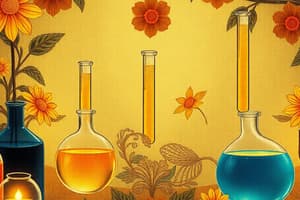Podcast
Questions and Answers
What is the function of the solvent reservoir in HPLC?
What is the function of the solvent reservoir in HPLC?
- To generate pressures up to 6000 Ibs/in2
- To provide a flow of the mobile phase through the HPLC injector, column, and detector (correct)
- To prevent damage to the pump, injector valve, or clogging of the column
- To remove dissolved gasses like oxygen from the mobile phase
What are the requirements of a standard HPLC pump?
What are the requirements of a standard HPLC pump?
- Pulse-free output and fixed flow rate
- Generation of pressures up to 6000 Ibs/in2 and constant flow
- Made of corrosion-resistant materials (stainless steel) and variable flow rate
- Flow rate ranging from 0.1 to 10 ml/min and constant pressure (correct)
What is the main difference between isocratic and gradient elution?
What is the main difference between isocratic and gradient elution?
- The pump is responsible for isocratic elution, whereas the solvent reservoir is responsible for gradient elution
- The mobile phase composition remains constant throughout the separation process in isocratic elution, while it changes in gradient elution (correct)
- Isocratic elution reduces tailing and gives sharp peak, while gradient elution shortens the analysis time
- Isocratic elution involves constant pressure, while gradient elution involves constant flow
Which type of elution leads to shortening the analysis time and reducing tailing for sharp peaks?
Which type of elution leads to shortening the analysis time and reducing tailing for sharp peaks?
What is a common function of the filtration system in the solvent reservoir?
What is a common function of the filtration system in the solvent reservoir?
What does the pump in HPLC provide?
What does the pump in HPLC provide?
What is the purpose of decreasing the retention of the last eluting peak in HPLC?
What is the purpose of decreasing the retention of the last eluting peak in HPLC?
What is the function of a fixed-volume loop in HPLC?
What is the function of a fixed-volume loop in HPLC?
What material are HPLC columns typically made from?
What material are HPLC columns typically made from?
What is the purpose of a guard column in HPLC?
What is the purpose of a guard column in HPLC?
What type of surface does a reversed-phase stationary phase have in HPLC?
What type of surface does a reversed-phase stationary phase have in HPLC?
What is the ideal characteristic for the response time of a column in HPLC?
What is the ideal characteristic for the response time of a column in HPLC?
What characteristic does an ideal HPLC column have in terms of stability and reproducibility?
What characteristic does an ideal HPLC column have in terms of stability and reproducibility?
What is the purpose of frits at the ends of an HPLC column?
What is the purpose of frits at the ends of an HPLC column?
What is a key requirement for an HPLC column in terms of sensitivity?
What is a key requirement for an HPLC column in terms of sensitivity?
What is the principle behind UV Absorption Detectors in HPLC?
What is the principle behind UV Absorption Detectors in HPLC?
According to Beer’s Law, what does 'A' represent in the equation A = -log(I/Io) = εbC?
According to Beer’s Law, what does 'A' represent in the equation A = -log(I/Io) = εbC?
For which type of compounds are UV Absorption Detectors in HPLC best suited?
For which type of compounds are UV Absorption Detectors in HPLC best suited?
What type of solvents are required for UV Absorption Detectors in HPLC?
What type of solvents are required for UV Absorption Detectors in HPLC?
What is the main advantage of fixed wavelength UV Absorption Detectors in HPLC?
What is the main advantage of fixed wavelength UV Absorption Detectors in HPLC?
What type of compounds have a poor response with UV Absorption Detectors in HPLC?
What type of compounds have a poor response with UV Absorption Detectors in HPLC?
Flashcards are hidden until you start studying
Study Notes
- The text discusses the key components and processes in High Performance Liquid Chromatography (HPLC).
- The HPLC system consists of a solvent reservoir, a pump, a sample injection system, columns and stationary phase, and detectors.
- The solvent reservoir holds the mobile phase, typically contains a filtration system, and may have a degasser.
- The pump provides a consistent flow of the mobile phase, generating pressures up to 6000 Ibs/in2 and maintaining pulse-free output.
- HPLC is mainly used with packed columns, which are made from stainless steel and have lengths between 3-50 cm and diameters between 3-10 mm.
- Columns are filled with stationary phases, like silica gel, and have porous materials to allow sample interaction and separation.
- The sample injection system is responsible for introducing samples into the HPLC system, using a fixed-volume loop (1 - 200 µl).
- HPLC columns have different surface polarities, like silica gel or derivatized silica gel, and can be used with polar or non-polar stationary phases.
- The ideal characteristics of HPLC columns include high sensitivity, good stability, wide linear dynamic range, short response time, insensitivity to changes, and ease of use.
- UV Absorption Detectors are the most common type in HPLC systems, using the absorption of ultraviolet or visible light according to Beer's Law.
- UV Absorption Detectors require solvents that absorb poorly in UV, and have different sensitivities and selectivities depending on wavelength.
- The detectors can be fixed wavelength or variable wavelength, using monochromators to select a specific wavelength.
Studying That Suits You
Use AI to generate personalized quizzes and flashcards to suit your learning preferences.




